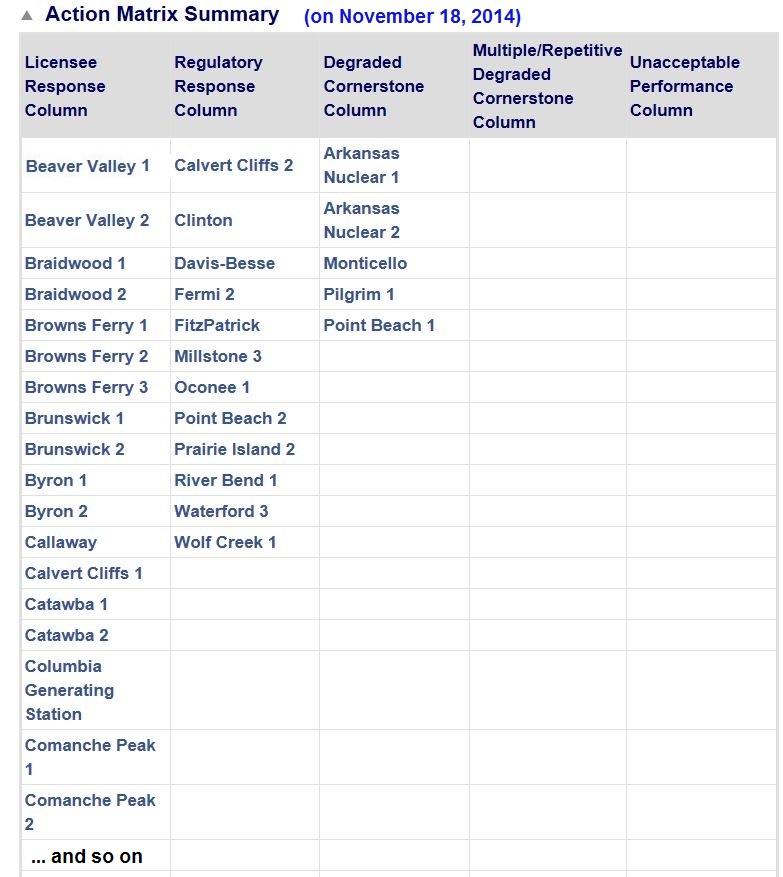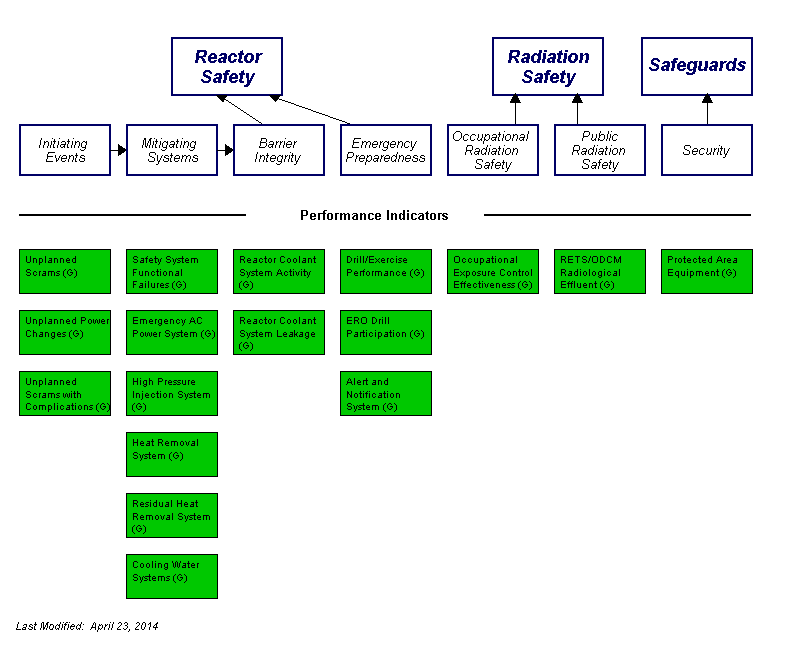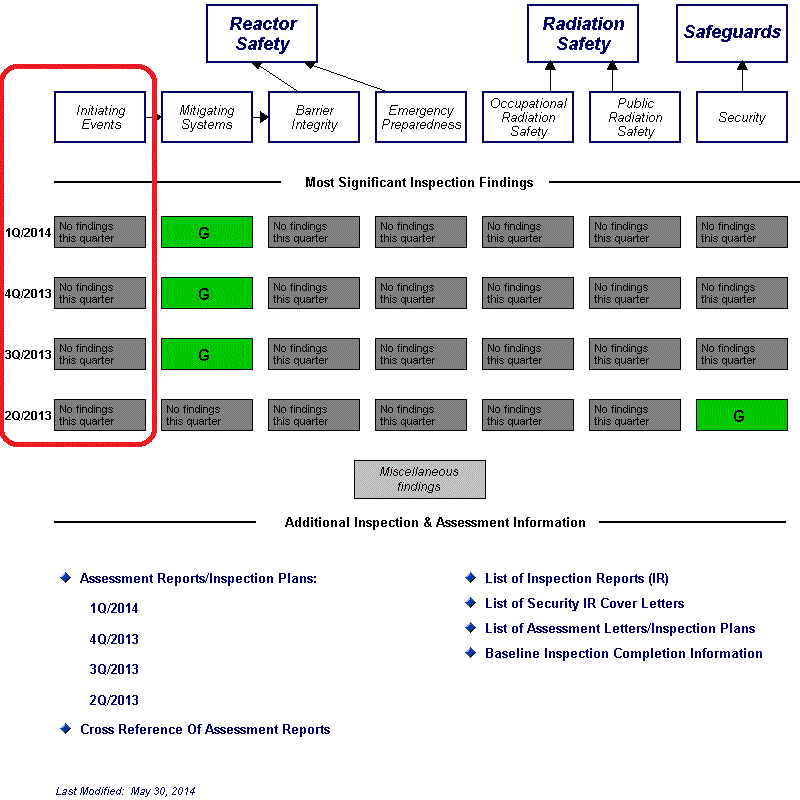Fission Stories #176
On June 23, 2014, NRC issued two yellow findings, the second most serious among the agency’s four color-coded sanctions, to the owner of the Arkansas Nuclear One plant for violations identified during a March 31, 2014, fatal accident.
My mistake. That fatal accident did not occur in March 2014. It happened on March 31, 2013—or “only” 449 days before the NRC issued the applicable sanctions.
What took the NRC so long?
The NRC announced on April 8, 2013, that it was sending an augmented inspection team to the site—only 8 days after the accident.
The NRC team dispatched to the plant to investigate the accident concluded its onsite efforts on May 9, 2013—only 39 days after the accident.
The NRC released the augmented inspection team’s report on June 7, 2013—only 68 days after the accident.
These response times are consistent with NRC’s procedures and practices. If anything, the NRC team’s onsite work and ensuing report were completed in shorter than typical times.
Then the NRC seems to have lost interest and motion.
The NRC did not issue its preliminary assessment of the severity of the violations identified by its augmented inspection team until March 24, 2014—or “only” 358 days after the accident and “only” 290 days after the report was issued.
And then it took the NRC another three months—or 91 days—to finalize the sanction levels.
So, it took “only” 449 days for the NRC to issue sanctions for safety violations associated with a fatal accident at Arkansas Nuclear One.
Our Takeaway
There’s an old saying that justice delayed is justice denied.
449 days clearly reflects the NRC delaying justice.
Thus, the NRC denied justice in this matter.
I’m neither a lawyer nor did I stay at a Holiday Inn Express last night, but would the NRC’s denying justice in this case also constitute its obstructing justice?
Regardless of the legal semantics, the NRC let the people of Arkansas down by taking so long to issue appropriate sanctions. And here’s why timeliness is a vital element of nuclear safety.
The NRC has used its Reactor Oversight Process (ROP) since the spring of 2000 to evaluate safety levels at operating nuclear power reactors and allocate its inspection resources.
All reactors receive the ROP’s baseline inspection effort. This baseline effort consists of many inspections conducted every year, some inspections conducted every other year, and a small group of inspections conducted once every three years.
Accompanying this baseline inspection effort are 17 performance indicators complied by the plant owners and submitted to the NRC every quarter.
The NRC considers the findings from its inspections and the performance indicator data in assessing the safety levels and assigning each nuclear power reactor to one of five columns within the ROP’s Action Matrix (Figure 1). When all requirements and expectations are met, reactors fall into the left-most column, called the Licensee Response Column. As inspection findings and/or performance indicators flag declining performance, reactors move into columns to the right.
Reactors residing in Column 1 of the Action Matrix receive the ROP’s baseline inspection effort—no more and no less. The baseline inspection effort strives to monitor discrete areas frequently enough to detect declining safety levels before problems grow to epidemic proportions.
Reactors in Columns 2, 3, 4, and 5 of the Action Matrix receive more and more NRC inspection effort. The additional NRC efforts have two purposes: (1) to ascertain whether the sign(s) of declining performance are isolated or reflective of broader, systemic problems, and (3) to ensure that remedies to the identified problem(s) are effective.
The performance indicators for Arkansas Nuclear One Unit 1 have been green for the past year (Figure 2).
The NRC inspection findings for Arkansas Nuclear One Unit 1 have been green or non-existent for the past year, but artificially so (Figure 3).
The NRC determined that violations of regulatory requirements identified during its investigation of the March 31, 2013, fatal accident fell within the Initiating Events cornerstone of the ROP and were serious enough to warrant two yellow findings. The accident occurred in the first quarter of 2013, yet the NRC showed no inspection findings of any color in the Initiating Events cornerstone during the 2nd, 3rd, and 4th quarters of 2013 and the 1st quarter of 2014.
By delaying issuing the yellow sanctions, the NRC denied justice its due. More importantly, the NRC also delayed implementing the additional inspections that such declining safety levels warranted.
The ROP seeks to protect the people living around nuclear power plants by detecting declining safety levels as near to their onset as practical and calling in the NRC cavalry to stem the decline. There’s no acceptable excuse for the NRC taking so long to reach its yellow determinations in this case and delay dispatching its cavalry for so long. The people of Arkansas deserve better protection from the NRC.
The NRC also did a disservice to the plant’s owner by delaying the sanction for so long. It would be unfair for my parents to ground me for a week now for an infraction I may have committed while in high school. It is similarly unfair for the NRC to discipline the owner now for bad behavior so long ago and likely long since corrected.
September 5, 2013, have been an appropriate timeframe for NRC to have issued its yellow findings. That would have been 158 days after the accident and 90 days after the NRC augmented inspection team’s report was issued. Because the ROP assesses safety levels on a quarterly basis, the NRC’s process for determining the severity of violations needs to take no longer than 90 days.
“Fission Stories” is a weekly feature by Dave Lochbaum. For more information on nuclear power safety, see the nuclear safety section of UCS’s website and our interactive map, the Nuclear Power Information Tracker.



